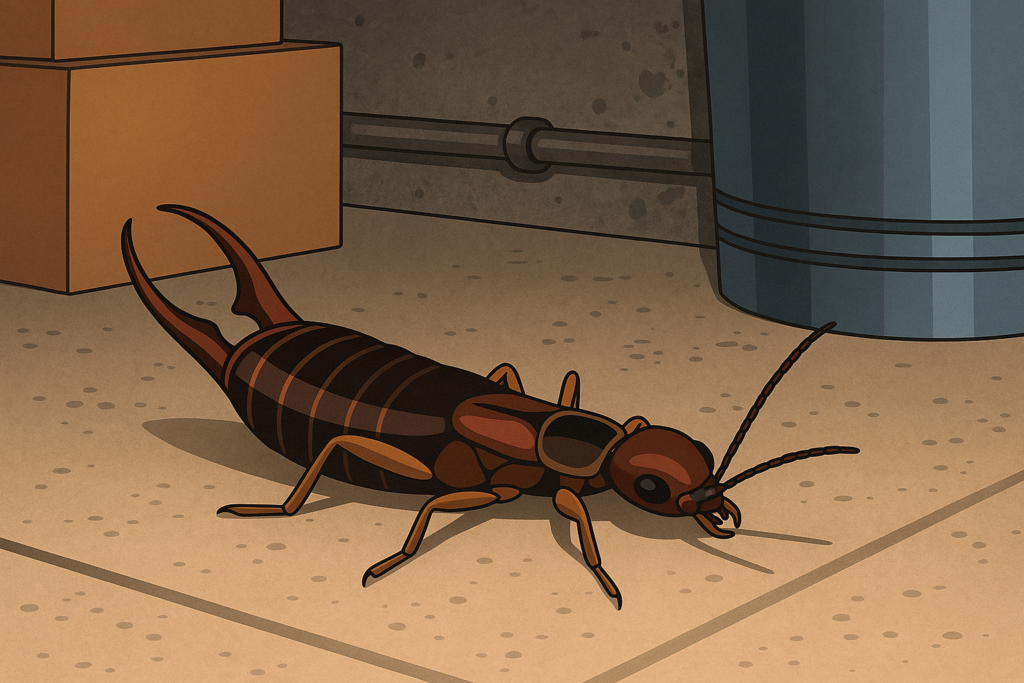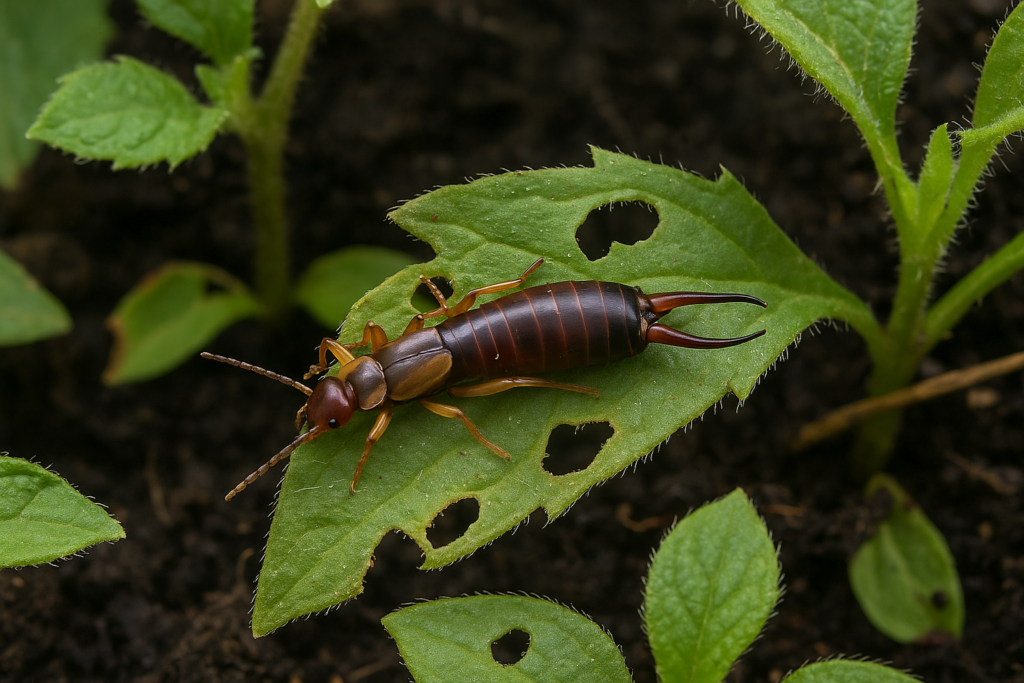Introduction
Have you ever spotted a creepy-looking bug with a pincher tail crawling through your bathroom or hiding in your mulch pile? If so, you’ve likely encountered a pincher bug—a nickname that makes this common insect sound far scarier than it actually is.
Also known as earwigs, pincher bugs are often misunderstood and mistakenly feared. From wild myths about them crawling into your ear to concerns about whether pincher bugs are poisonous or dangerous, these small invaders spark a lot of questions. People often ask: “Are pincher bugs harmful?” or “Why do I have pincher bugs in my house?”
In this guide, we’ll break down 10 shocking facts about pincher bugs that every homeowner, gardener, or bug-curious reader should know. You’ll learn the truth about pincher bug vs earwig, what they eat, how to spot an infestation, and—most importantly—how to get rid of pincher bugs, whether they’re in your garden or inside your Midwest home.
Let’s separate fact from fiction and uncover everything there is to know about these odd little insects.
1. Pincher Bugs and Earwigs Are the Same Insect
One of the most surprising facts is that a pincher bug is not a separate species—it’s just another name for an earwig. This nickname comes from the insect’s most distinctive feature: the pair of forcep-like appendages at the end of its abdomen, which look like tiny pinchers.
Scientifically known as Dermaptera, earwigs have elongated, flat bodies and range in size from 5mm to 25mm. Their “pinchers,” officially called cerci, vary in shape between males and females and are primarily used for defense and mating displays—not for harming humans.
So when you hear someone talk about a bug with a pincher on its back, a pinching bug, or a bug with a pincher tail, they’re all likely describing the same thing: an earwig.
If you’re comparing pincher bug vs earwig, you’re essentially asking, “What’s the difference between a nickname and a scientific term?”
🔍 Fun Fact: Despite popular belief, pincher bugs don’t crawl into your ears—this is a myth likely rooted in their misleading name.
2. Pincher Bugs Love Damp, Dark Spaces in Your Home

If you’ve found pincher bugs in the house, especially in basements, bathrooms, or laundry rooms, you’re not alone. These insects are drawn to moisture, darkness, and organic matter, making certain areas of your home an ideal habitat.
Places where you’re most likely to find pincher bugs indoors include:
- Under sinks and around leaky plumbing
- Behind appliances
- In piles of wet laundry
- Inside basements and crawlspaces
- Near door thresholds with high humidity
But why do I have pincher bugs in my house in the first place?
Here’s what likely brought them inside:
- Outdoor mulch or leaf litter close to your home’s foundation
- Excessive indoor humidity or water leaks
- Poorly sealed windows and doors
- Pet food or crumbs left out overnight
Once inside, they’ll continue searching for food and moisture. While they don’t breed indoors often, they can be a recurring nuisance during warm, wet seasons—especially if your home is in the Midwest or coastal areas.
3. Pincher Bugs Are Not Poisonous—But They Might Pinch
Let’s clear this up: pincher bugs are not poisonous.
They don’t have venom, they don’t carry toxic saliva, and they certainly don’t inject anything harmful with their cerci. Still, if you try to handle one or corner it, it may use those rear pincers to give you a little pinch.
So, do pincher bugs pinch? Yes—especially the larger males. But the pinch is superficial, more of a scare tactic than a serious threat. It won’t break skin or inject venom.
Some people wonder: what does a pincher bug bite look like? The answer is… nothing! That’s because pincher bugs don’t bite. If you do see a small red mark after an encounter, it was likely from a pinch or a coincidental reaction.
To summarize:
- ✅ Do they bite? No.
- ✅ Do they pinch? Rarely, and it’s harmless.
- ✅ Are pincher bugs dangerous? Not in any medically significant way.
They may look intimidating, but pincher bugs are far less aggressive than their appearance suggests.
4. Pincher Bugs Are Not Harmful to Humans
Many people ask, are pincher bugs harmful? The answer is no—at least not to humans. They don’t transmit disease, don’t contaminate food, and don’t infest bedding or bite like bed bugs.
In fact, the worst harm they cause is psychological. Their sudden appearance in your sink or bathtub can be alarming, especially given their creepy look and wriggly movements. But that’s about it.
Common myths debunked:
- ❌ They don’t crawl into your ear (a myth from European folklore).
- ❌ They don’t inject venom.
- ❌ They won’t infest your body or pets.
Instead, pincher bugs prefer damp, plant-rich areas where they can hide during the day and forage at night.
However, like most pests, a large pincher bug infestation can become a nuisance, especially if moisture issues in your home go unresolved.
5. Pincher Bugs Are Omnivores
So, what do pincher bugs eat? Just about anything soft and organic.
Pincher bugs are opportunistic omnivores, meaning they feed on both plant and animal material. Their diet includes:
- Dead insects and decaying matter
- Flower petals and soft plant shoots
- Mold and fungus
- Fruits and vegetables (especially if decaying)
- Small insects or insect eggs
This broad diet is one reason why pincher bugs are often found in compost piles, flowerbeds, and mulched areas around the yard.
In small numbers, they’re actually beneficial, helping decompose organic matter and controlling pest populations like aphids and mites. But in larger numbers—especially in moist, plant-rich areas—they can damage garden plants and seedlings.
A fun observation: Pincher bugs are nocturnal, so if you’re wondering who’s been nibbling your plants overnight, it might just be them.
6. Pincher Bugs Can Damage Plants and Gardens

If you’re a gardener, pincher bugs might become your least favorite guests. While they’re not nearly as destructive as caterpillars or beetles, they can still damage plants, especially seedlings, soft fruit, and flower petals.
Typical signs of pincher bug damage in gardens include:
- Ragged edges on petals and leaves
- Holes in seedlings and soft shoots
- Chewed fruit or vegetables (especially corn silks, strawberries, and tomatoes)
- Pincher bugs hiding under mulch, flowerpots, or decorative stones
Still, pincher bugs aren’t all bad. In controlled numbers, they help eat up aphids, maggots, and decaying matter. But when they overpopulate—often due to excessive mulch or moisture—they become a problem.
If you notice consistent nighttime plant damage and find bugs with pincher tails nearby, it’s safe to suspect them.
Quick Tips to Minimize Garden Damage:
- Use dry mulch or reduce mulching altogether.
- Water early in the day to reduce evening dampness.
- Remove hiding spots like wood piles, rocks, and debris.
- Set up simple newspaper traps or oil traps to collect them at night.
7. Midwest Homes Are Especially Prone to Infestations
If you live in the Midwest, chances are you’ve already dealt with a pincher bug infestation—especially during spring and late summer. These regions experience higher humidity, fluctuating weather, and heavy rainfalls, creating ideal conditions for earwigs to thrive.
After periods of heavy rain, pincher bugs are often flushed out of their underground hiding spots. As they search for drier environments, they slip under doorways, crawl through foundation cracks, and settle in basements or laundry rooms.
Midwest-Specific Risk Factors:
- High outdoor moisture leads to migration indoors.
- Basement-heavy homes provide cool, damp environments.
- Mulch and decorative landscaping create hiding and nesting zones.
Homeowners in these regions often report sightings in:
- Bathtubs
- Kitchens
- Crawlspaces
- Along window sills and thresholds
If you’re in a state like Illinois, Iowa, or Ohio, knowing how to get rid of pincher bugs in Midwest house environments is crucial for long-term control.
8. What Attracts Pincher Bugs?
Ever ask yourself, what are pincher bugs attracted to? You’re not alone. Understanding what draws them in is the first step to prevention.
Key Attractants:
- Moisture: Damp basements, leaky pipes, wet towels
- Organic Matter: Mulch, compost, leaf litter, decaying plants
- Darkness: They’re nocturnal and hide from sunlight
- Crumbs or Pet Food: Especially if left out overnight
- Cracks and Gaps: Unsealed doors, windows, foundation gaps
Even outdoor lighting can attract pincher bugs at night. Like many insects, they may follow the light source, especially near entry points to your home.
Indoor Hotspots:
- Bathrooms
- Kitchens (under sinks)
- Laundry areas
- Basements
- Behind refrigerators or washing machines
By reducing these attractants, you lower the chances of a pincher bug infestation.
✅ Pro Tip: Use a dehumidifier in problem areas to dry out the environment.
9. You Can Get Rid of Pincher Bugs Naturally and Chemically
Wondering how to get rid of pincher bugs for good? You have multiple options—ranging from simple DIY methods to targeted chemical treatments.
Indoor Remedies
✅ Seal Entry Points
- Caulk cracks around baseboards and windows
- Install weather stripping under doors
- Check dryer vents and plumbing gaps
✅ Reduce Moisture
- Use dehumidifiers
- Fix leaky faucets and pipes
- Keep bathrooms and kitchens dry
✅ Clean Regularly
- Sweep up crumbs and debris
- Don’t leave pet food out overnight
- Wipe under appliances and sinks
✅ DIY Traps
- Newspaper Trap: Roll damp newspaper and leave it overnight. Dispose in the morning.
- Soy Sauce and Oil Trap: In a shallow container, mix soy sauce and a bit of oil. Place near infestation zones.
Outdoor Strategies
✅ Landscape Control
- Keep mulch away from your home’s foundation
- Rake up leaf litter and dead plants
- Avoid over-watering garden beds
✅ Natural Predators
- Birds, frogs, and toads help control populations
- Chickens and ducks (if you keep them) also feed on pincher bugs
Chemical Solutions (For Severe Infestations)
Indoor:
- Boric Acid: Use only in non-pet zones
- Diatomaceous Earth (Food Grade): Safe and natural, it cuts into their exoskeleton and dehydrates them
- Targeted Insecticides: Use sprays labeled for indoor earwig control (follow directions)
Outdoor:
- Perimeter Spray: Apply along the foundation and entry points
- Granular Baits: Scatter around garden beds and mulch zones
✅ Helpful Resource: University of Wisconsin-Madison Extension – Managing Earwigs
Always start with natural solutions and escalate to chemicals only when needed.
10. Knowing the Truth About Pincher Bugs Helps You Stay Calm
Despite their alarming appearance, pincher bugs aren’t out to get you. They’re not venomous, they don’t bite, and they won’t crawl into your ears. Once you understand their habits and behavior, you’ll realize that these creepy crawlies are more nuisance than threat.
By learning to identify what attracts them and how to control moisture and shelter, you’ll be better prepared to manage or even prevent a pincher bug infestation entirely.
Remember:
- Keep your home dry and sealed
- Check mulch and compost areas outdoors
- Don’t panic if you see one—they’re harmless
Conclusion
Pincher bugs may look terrifying, but the truth is much less dramatic. These misunderstood insects are mostly harmless to humans, helpful in small numbers outdoors, and completely controllable with the right knowledge.
Let’s recap what you now know:
- Pincher bugs and earwigs are the same.
- They don’t bite, aren’t poisonous, and are not harmful.
- They thrive in moisture, making Midwest homes a target.
- You can get rid of them naturally or with safe insecticides.
- Knowing the facts reduces fear and leads to better prevention.
Keep your space dry, clean, and sealed—and you’ll rarely see one again.
Additional Resources
For further information and assistance:
- National Pest Management Association
- Website: Earwigs



